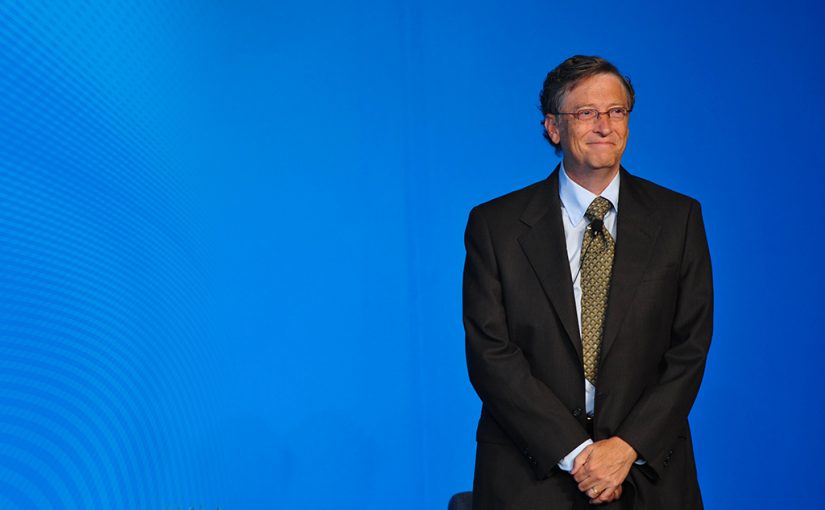“Be nice to nerds. Chances are you’ll end up working for one.”
Self-styled nerd Bill Gates said that, the same Bill Gates who co-founded Microsoft, only the most successful software business ever, and who for 13 years was the world’s richest person (now that is Jeff Bezos of Amazon, though Gates is still second with an estimated net worth of just under $100 billion).
Background and Education
Born in 1955 to an upper-middle-class family in Seattle, Washington, Gates does not come with a rags-to-riches story that so many Americans love, but his ascendance to the pinnacle of the business world was not without risks and setbacks.
For instance, Gates dropped out of Harvard in 1975 after not two full years there. Normally, one would consider it crazy to drop out of Harvard when an undergraduate degree from there virtually guarantees lucrative job offers, but Gates had bigger goals: going into business for himself and revolutionizing the computer industry.
Although this was disappointing to Gates’s parents and some others close to him, it was not exactly surprising, for it was in keeping with his record up to that point.
Worried that their brilliant child was bored and withdrawn in school and would suffer academically and socially, Gates’s parents withdrew him from public school and enrolled him in the prestigious Lakeside School when he was 13. There, he excelled, particularly in science and math, and he developed a fascination with computers and began writing his own programs.
While at Lakeside, Gates met Paul Allen, who shared a love of computers, and the two became close friends and spent many hours in the school’s computer lab creating and running programs. For a brief period, they actually lost their computer privileges for hacking into the company that provided the school’s computers. The hacking was not to cause damage; it was to obtain extra free computer time.
The two regained access to the lab after offering to debug the system they had hacked, and they also created a payroll program for the company and a scheduling program for the school. When Gates was 15, he and Allen created their own business, developing “Traf-o-Data,” a program that monitored Seattle’s traffic patterns.
At this point, Gates already wanted to leave school and go into business full-time with Allen, but his parents insisted he finish high school and go to college. They won that round.
Into the Business World
Allen, two years Gates’s senior, attended Washington State (like Gates, he dropped out in order to go into tech), but the two remained close after Allen’s graduation and Gates’s matriculation to Harvard, and they continued to explore programming and plan business ventures.
And so in 1975 Gates left Harvard and with Allen founded “Micro-Soft,” soon to become Microsoft, initially selling BASIC software. At first, the company struggled, but by 1979 Microsoft was performing well, and the business really took off in 1981 and 1982 when Microsoft won the right to develop software for IBM, and when in 1985 Microsoft launched Windows, a user-friendly format to replace the complicated MS-DOS system, the company became a true colossus. Gates was CEO and chairman of the board.
In 1986, with Microsoft’s IPO, Gates became an instant millionaire. A year later, he was a billionaire at just 31 and on his way to becoming the wealthiest person in the world.
Gates’s rise was not without controversy. He had a reputation for being competitive and aggressive (some said ruthless) , and he sometimes used lawsuits and even bluffing to gain advantage (one infamous bluff was announcing Windows when in fact it had not yet been created). During the 1990s, there were investigations by the Justice Department and the Federal Trade Commission into alleged unfair business practices. Nevertheless, Microsoft endured and thrived.
Today, Gates no longer plays a role in the day-to-day operations of Microsoft. In 2000, Gates passed off the CEO role to focus on software but remained chairman. Gates’s last full day at Microsoft was in 2008, and in 2014 he left the chairman position.
After Microsoft
Now Gates and his wife, Melinda, mostly focus on charitable work. Together, they founded the Bill and Melinda Gates Foundation in 2000, with a priority on education, health, and investment for low-income areas worldwide. Gates has also invested in research for a universal flu vaccine, Alzheimer’s research, and development of a “smart city” in Arizona. Like Andrew Carnegie and John D. Rockefeller before him, Gates has found an obligation to use much of his incredible fortune to give back and to help the disadvantaged.

